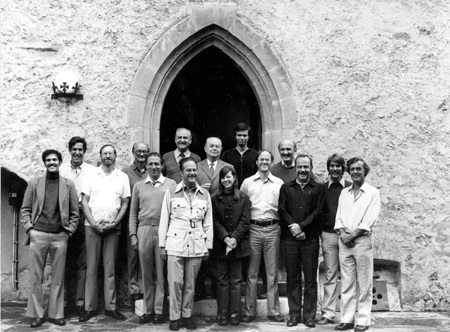Prehistoric Settlement Pattern Studies: Retrospect and Prospect
Date
Aug 16-24, 1980Organized by
Evon Z. VogtLocation
Burg Wartenstein Conference CentePublications
Prehistoric Settlement Pattern Studies: Essays in Honor of Gordon R. Willey (E.Z. Vogt and R.M. Leventhal, Eds.) Harvard University Press, Cambridge, Massachusetts, 1983.Participants
- R.E.W. Adams University of Texas, San Antonio, USA
- Warwick Bray University of London, UK
- David A. Freidel Southern Methodist University, USA
- Alberto Rex Gonzalez Universidad de La Plata, Argentina
- Wolfgang Haberland Hamburgisches Museum fur Volkerkunde, Germany
- Richard M. Leventhal Peabody Museum, USA
- Joyce Marcus University of Michigan, USA
- Michael E. Moseley Field Museum of Natural History, USA
- H.B. Nicholson University of California, Los Angeles, USA
- Lita Osmundsen Wenner-Gren Foundation, USA
- William L. Rathje University of Arizona, USA
- Jeremy A. Sabloff University of New Mexico, USA
- Donald E. Thompson University of Wisconsin, USA
- Gair Tourtellot Michigan State University, USA
- Evon Z. Vogt Harvard University, USA
- Gordon R. Willey Peabody Museum, USA
ORGANIZER’S STATEMENT: “Gordon R. Willey has played a major role in the development of anthropology during the past forty years. He has been innovative in developing and applying new methodological and theoretical approaches to the understanding of man’s prehistory and in identifying new trends in archaeology. As this volume and its companion can attest, he has also helped his colleagues and students focus these trends into productive channels….”
“But there is clearly one area of anthropology in which Willey’s contributions have been fundamental: the initial development and utilization of settlement pattern studies in the New World. We are not certain that Willey would claim to have been the first to perceive a need for settlement pattern research in our examination of the prehistory of man. But it is clear that he quickly recognized the importance of such an approach and was in the forefront of developing settlement pattern studies as the cornerstone of many of the models of man’s past. Indeed, in retrospect, it seems that settlement pattern studies were in the vanguard of the “new archaeology” of the late 1950s and early 1960s. Today, settlement archaeology is no longer just the examination of house sites within a settlement, but rather emphasizes a complete or “holistic” view of the past. Settlement pattern studies are continuing to help form the methodological, and occasionally the theoretical, basis for examining an ancient culture as a whole, including its social structure, ideology, iconography, and economy.
This point is clearly underlined in the articles in this volume, focusing on some methodological issues and several specific settlement pattern studies that have recently been conducted by students and colleagues of Gordon Willey throughout the world. The articles are, in effect, an indication of the vitality and importance of the settlement pattern concepts in archaeological thinking and a measure of the breadth and diversity of Willey’s interests.”
(excerpt from the introduction to “Prehistoric Settlement Patterns” by Evon Z. Vogt and Richard M. Leventhal)
Wenner-Gren Symposium #86
